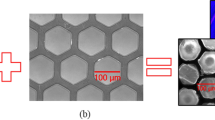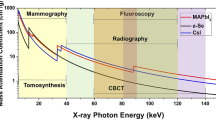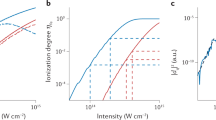Abstract
High-harmonic generation (HHG) offers better coherence1, shorter pulse durations2 and far greater accessibility than synchrotron sources3. These factors make HHG an increasingly important source of soft X-rays and an excellent resource in many emerging areas, for example, the time-resolved study of conformational changes in single biological molecules4. Here, we demonstrate a novel technique that enables us to reconstruct spectral information spatially across an X-ray beam. As only a single diffraction image is required per measurement, this technique is well suited to time-resolved studies. This technique is applicable to many types of X-ray source3,5,6,7 and can be adapted for different spectral regions. Here, results are obtained using a capillary high-harmonic source8, revealing detailed information that brings new insight into the physical processes occurring inside the source and enabling us to show the first measurement of radial variation of harmonic order in the emission from an HHG capillary.
This is a preview of subscription content, access via your institution
Access options
Subscribe to this journal
Receive 12 print issues and online access
$259.00 per year
only $21.58 per issue
Buy this article
- Purchase on SpringerLink
- Instant access to full article PDF
Prices may be subject to local taxes which are calculated during checkout




Similar content being viewed by others
References
Bartels, R. A. et al. Generation of spatially coherent light at extreme ultraviolet wavelengths. Science 297, 376–378 (2002).
Hentschel, M. et al. Attosecond metrology. Nature 414, 509–513 (2001).
Cavalieri, A. L. et al. Clocking femtosecond x rays. Phys. Rev. Lett. 94, 114801 (2005).
Neutze, R., Wouts, R., van der Spoel, D., Weckert, E. & Hajdu, J. Potential for biomolecular imaging with femtosecond X-ray pulses. Nature 406, 752–757 (2000).
Tamaki, Y., Itatani, J., Nagata, Y., Obara, M. & Midorikawa, K. Highly efficient, phase-matched high-harmonic generation by a self-guided laser beam. Phys. Rev. Lett. 82, 1422–1425 (1999).
Salieres, P., L’Huillier, A. & Lewenstein, M. Coherence control of high-order harmonics. Phys. Rev. Lett. 74, 3776–3779 (1995).
Dromey, B. et al. High harmonic generation in the relativistic limit. Nature Phys. 2, 452–455 (2006).
Froud, C. A. et al. Soft-x-ray wavelength shift induced by ionization effects in a capillary. Opt. Lett. 31, 374–376 (2006).
Rundquist, A. et al. Phase-matched generation of coherent soft x-rays. Science 280, 1412–1415 (1998).
Christov, I. P. Enhanced generation of attosecond pulses in dispersion-controlled hollow-core fiber. Phys. Rev. A 60, 3244–3250 (1999).
Pfeifer, T. et al. Spatial control of high-harmonic generation in hollow fibers. Opt. Lett. 30, 1497–1499 (2005).
Wagner, N. L. et al. Self-compression of ultrashort pulses through ionization-induced spatiotemporal reshaping. Phys. Rev. Lett. 93, 173902 (2004).
Durfee, C. G. et al. Phase matching of high-order harmonics in hollow waveguides. Phys. Rev. Lett. 83, 2187–2190 (1999).
Paul, A. et al. Phase-matching techniques for coherent soft x-ray generation. IEEE J. Quantum Electron. 42, 14–26 (2006).
Born, M. & Wolf, E. Principles of Optics, Theory of Propagation, Iterference and Diffraction of Light 7th edn (Cambridge Univ. Press, Cambridge, 1999).
Lewenstein, M., Salieres, P. & L’Huillier, A. Phase of the atomic polarization in high-order harmonic-generation. Phys. Rev. A 52, 4747–4754 (1995).
Bellini, M. et al. Temporal coherence of ultrashort high-order harmonic pulses. Phys. Rev. Lett. 81, 297–300 (1998).
Lawson, C. L. & Hanson, R. Solving Least Squares Problems Ch. 23, 161 (Prentice-Hall, New Jersey, 1974).
Acknowledgements
This work was supported by the UK Research Councils through the Basic Technology Programme.
Author information
Authors and Affiliations
Contributions
Experimental work: M.P., A.M.dP., C.A.F., S.L.S. Data analysis: M.P., E.T.R., W.S.B., J.J.B. Writing: M.P., A.M.dP., C.A.F., E.T.R., S.L.S., W.S.B., J.J.B., D.C.H., J.G.F. Project planning: W.S.B., J.J.B., D.C.H., J.G.F.
Corresponding author
Ethics declarations
Competing interests
The authors declare no competing financial interests.
Supplementary information
Rights and permissions
About this article
Cite this article
Praeger, M., de Paula, A., Froud, C. et al. Spatially resolved soft X-ray spectrometry from single-image diffraction. Nature Phys 3, 176–179 (2007). https://doi.org/10.1038/nphys516
Received:
Accepted:
Published:
Issue date:
DOI: https://doi.org/10.1038/nphys516
This article is cited by
-
Efficient high-harmonic generation from a stable and compact ultrafast Yb-fiber laser producing 100 μJ, 350 fs pulses based on bendable photonic crystal fiber
Applied Physics B (2017)
-
Real-time and Sub-wavelength Ultrafast Coherent Diffraction Imaging in the Extreme Ultraviolet
Scientific Reports (2014)



